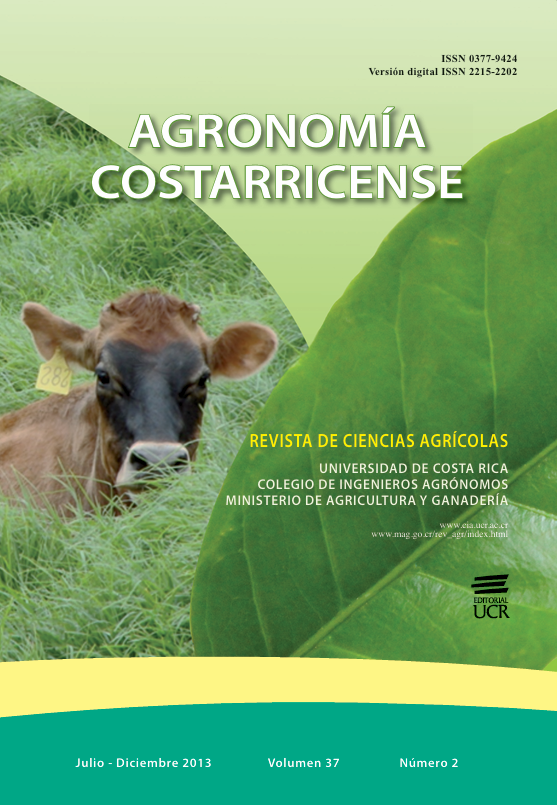Abstract
The goal of this study was to make and validate interpolated maps of 6 soil fertility variables. The maps were made from the results of Ca, pH, soil acidity, K, P and saturation of soil acidity of 138 soil samples that were taken from 1011 ha at Atirro, Costa Rica. The data were interpolated through ordinary Kriging. The validation was carried out using “field validation” and “cross validation” methods. Correlation coefficient (r) was estimated for both techniques between real and prediction values, and the prediction efficiency (E) as well. Other validation criteria used were the percent success by overlapping between real and estimated values, according to the uncertainty of soil analysis and to the success rate of overlap according to agronomic category. The r values using field validation varied from 0.09 to 0.87; and for cross validation were from 0.52 to 0.84. The variables Ca and pH had the highest prediction efficiency in both validation methods. The overlap criterium due to the uncertainty of analysis was 27 to 93% success, while the overlapping range that was due to agronomic category had 47 to 93% of success. In both cases, pH had the better values of success. It was concluded that the interpolated maps at a regional scale are a useful tool for to carrying out a good prediction on soil fertility properties, although it is important to perform a verification process in order to confirm these approximations, because this could change according to the type of variables.References
BERTSCH F. 1995. Fertilidad de suelos y su manejo. San José, Costa Rica. Asociación Costarricense de la Ciencia del Suelo (ACCS). 157 p.
BERTSCH F., HENRÍQUEZ C., RAMÍREZ F., SANCHO F. 2002. Site-Specific nutrient management in the highlands of Cartago province. Better Crops International 16(1):16-19.
CLAY D.E., KITCHEN N., CARLSON C.G., KLEINJAN J., CHANG H. 2007. Using historical management to reduce soil sampling errors, pp. 49-64. In: D. Clay and F. Pierce (ed.). GIS Application in Agriculture. CRC Press.
CORRALES M., BERTSCH F., BEJARANO J. 2005. Los laboratorios de análisis de suelos y foliares en Costa Rica: Informe del Comité de Laboratorios de análisis de suelos, plantas y aguas. Agronomía Costarricense 29(3):125-135.
DIAZ R., HUNTER A. 1978. Metodologías de muestreo de suelos, análisis químico de suelos y tejido vegetal y de investigación en invernadero. Turrialba, Costa Rica. CATIE. 62 p.
GALLARDO A. 2006. Geostadística. Ecosistemas 15(3):48-58.
HENRÍQUEZ C., KILLORN R., BERTSCH F., SANCHO F. 2005. La geostadística en el estudio de la variación espacial de la fertilidad del suelo mediante el uso del interpolador kriging. Agronomía Costarricense 29(2):73-81.
MUELLER T.G. 2007. Map quality assessment for sitespecific fertility management, pp.103-120. In: D. Clay and F. Pierce (ed.). GIS Application in Agriculture. CRC Press.
PETERSEN G.W., BELL J.C., MCSWEENEY K., NIELSEN G.A., ROBERT P.C. 1995. Geographic information systems in agronomy. Advances in Agronomy 55:67-105.
ROBINSON T.P., METTERNICHT G. 2006. Testing the performance of spatial interpolation techniques for mapping soil properties. Computers and Electronics in Agriculture 50:97–108.
TOMCZAK M. 1998. Spatial interpolation and it uncertainty using automated anisotropic inverse distance weighting (IDW) cross validation-Jackknife approach. Journal of Geographic Information and Decision Analysis 2(2):18-30.
TRANGMAR B.B., Post R.S., Uehara G. 1985. Application of geostatistics to spatial studies of soil properties. Advances in Agronomy. 38:45-94.
USDA. 2010. Keys to Soil Taxonomy, 11th ed. USDA-Natural Resources Conservation Service, Washington, DC. 365 p.
VILLATORO M., HENRÍQUEZ C., SANCHO F. 2008. Comparación de los interpoladores IDW y Kriging en la variación espacial de pH, Ca, CICE y P del suelo. Agronomía Costarricense 32(1):95-105.


